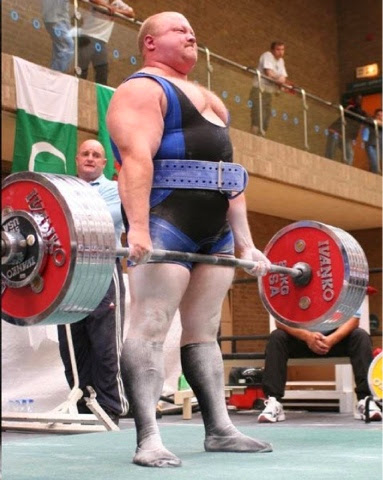So, what is fitness and why should we care? You should care because nothing is less manly than being an out of shape slob. But defining fitness is more involved. Fitness encompasses strength, cardiovascular endurance, flexibility, agility, and balance among other things. Different attributes lend themselves to different things. A power lifter needs tremendous strength. A marathon runner needs exceptional cardiovascular endurance. But which one is more fit?
Most of you have probably subconsciously picked the marathon runner. You envision the power lifter as obese and the marathon runner as toned. What if I told you that marathon runners suffer heart attacks more often than lifters? We'll get back to that. For now let's say that fitness is the ability to perform a physical task. Easy enough right? Sure. Let's look at the different areas of fitness.
Strength:
You can break strength into three main components. Maximal strength, endurance strength and power. Maximal strength is the ability to lift a very heavy weight one time. Think of power lifters lifting incredibly heavy weights in a competition.
Endurance strength is the ability to perform a set movement for very high repetitions. Think of a gymnast moving their body through as series of complex movements repeatedly.
Power is the ability to move a set weight very quickly. This is probably best expressed by Olympic lifters cleaning and snatching.
Just remember ladies, lifting weights will make you look like a man. I hope my sarcasm was apparent.
Cardiovascular Endurance:
On the surface cardio seems easy. You go run. That's cardio. Except of course it's not. Cardio can be split into two categories, aerobic and anaerobic. Aerobic is cardio performed at a steady pace. Running a 5k for instance. Anaerobic involves faster paced exertion such as sprints. There is far more to this subject involving energy pathways but this post is meant to serve as an overview.
There is a common misconception that cardio = running. The truth is that anything that gets your heart rate up and leaves you gasping for air has worked your cardio vascular system. Running, walking, skipping rope, riding a bike or even swinging a sledgehammer are all potential cardiovascular exercises.
Flexibility:
Flexibility or limberness refers to the absolute range of motion in a joint or series of joints, and length in muscles that cross the joints.
Irina Tchchina just chillin around the house. NBD.
We find flexibility, along with balance, expressed in gymnastics, yoga and dance.
Balance:
Balance is the ability to maintain the line of gravity of a body within the base of support with minimal postural sway. In layman's terms, not fall down.
As stated above balance shows up in gymnastics, yoga and dance. One wouldn't think it but a highly developed sense of balance is also vital to good form in weightlifting.
Agility:
Agility is the ability to quickly change directions. You see this every Friday night during football season. A running back needs speed and agility to evade the opposition and make a touchdown.
Hey Marcus, just for you it's a Duck.
Speed:
Speed is the art of getting from point A to point B in the least amount of time possible.
Coordination:
Coordination is simply getting all of your body parts and movements to work together smoothly. This is probably the simplest yet most vital attribute of fitness.
Body Composition:
Body comp refers to what your muscle to far percentages are. Obviously being lean is ideal for most sports. Notice I said lean not skinny. Lean means low body fat and as much muscle as you can pack on.
You can see the synergy and crossover of these different attributes. A healthy cardiovascular system can help with your endurance strength which in turn will train your body to flush away lactic acid quicker. Balance will help with Olympic lifts which can lead to greater strength and power. Speed and agility are close cousins.
So what is most important? Well, what are your goals? Getting thin? Playing football? Gymnastics? Running? All of those goals call for slightly different training. There is one place that all of them need to start however and that is with strength training. Strength is the base of all human endeavors from sprinting to moving a couch. In the next post in this series we'll delve deeper into strength training, methodologies, terms and techniques. Each attribute will be the focus of its own blog post down the line.








No comments:
Post a Comment